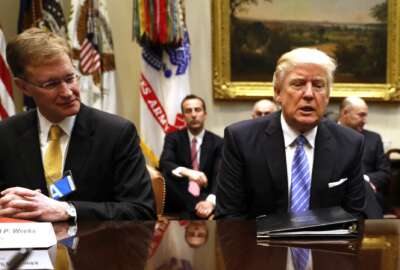
Military leaders say Pentagon’s hiring freeze exemptions don’t fully resolve civilian workforce concerns
Pentagon said exemptions to President Donald Trump's 90-day hiring freeze were not necessarily a resolution for civilian Defense employees, as some agencies are...
Although the Pentagon has issued high-level guidance on which civilian jobs might be exempt from the federal hiring freeze President Donald Trump ordered on Jan 23., the short-and-long term military readiness impacts of the administration’s commitment to reduce the size of the federal workforce are still somewhat unclear and potentially worrisome, senior military leaders told the Senate this week.
DoD found some relief from the hiring freeze last week when deputy Defense secretary Bob Work published a list of 16 broad categories in which the military secretaries and Defense agency heads could resume some hiring under an exemption in the President’s executive order for positions that are critical to national security.
But the list of exceptions was far from a complete lifting of the freeze for Defense employees. For instance, it leaves the hiring ban intact for DoD’s acquisition workforce.
Gen. Glenn Walters, the assistant commandant of the Marine Corps, said that fact alone presents challenges as the military attempts to follow through with Defense Secretary James Mattis’ orders to rebuild military readiness in 2017.
“We’re doing a lot of planning to increase readiness, grow the force, all of these things, but I’m 50 percent short of contracting officers already,” he told the Senate Armed Services readiness subcommittee. “If I can’t hire contracting officers, we can put any plan we want into place, but I can’t execute it. It’s not going to come to fruition. That’s just one of our challenges.”
And in some cases, commanders are still waiting for more detailed guidance on how to implement the freeze exceptions at the level of individual military bases and other facilities.
For instance, while last week’s guidance included exceptions for shipyard and depot maintenance workers, the deputy secretary also ordered that those exceptions be used sparingly, and said the military service secretaries will be held accountable for their decisions to classify any of the positions they choose to exempt from the freeze as truly critical to national security or public safety.
Because of that, Vice Adm. Bill Moran, the vice chief of Naval operations, says it’s still not entirely clear whether exceptions can be granted by lower-level officials at military installations.
“We have some pretty good assurances that we will be able to get exemptions for depots and our yards, but we’re still working through the mechanics of that,” he said. “The secretary of the Navy has been delegated the authority to allow for these exemptions. Does he have to sign each person’s exemption, or can we do these in groups based on input from lower echelons? I think we’re gonna get through this in the very near-term. But if [the freeze] were to endure, we’re basically back to the sequestration and furlough situation we had in 2013, which was devastating to our force. We really don’t want to go back there.”
To an still-uncertain degree, a widespread slowdown in federal hiring is almost certain to persist even after the expiration of the blanket governmentwide hiring freeze. The president’s executive order allows the freeze to be lifted after 90 days, but only after the Office of Personnel Management and the Office of Management and Budget develop and then implement a more detailed long-term plan to continue to shrink the federal workforce through attrition.
Whatever emerges from that yet-to-be-developed strategy, military officials say they need to be able to wall off at least some key segments of the civilian workforce that they view as essential to the Defense secretary’s newly-ordered effort to rebuild military readiness.
“96 percent of our civilian workforce works outside of Washington, D.C.,” said Gen. Stephen Wilson, the vice chief of staff of the Air Force. “They work in places like our depots, or on our flight lines. And if we can’t hire, then that has a direct impact to readiness. We think we’ve got the procedures in place to move through this for now, but we can’t have it slow down the hiring.”
Last week’s hiring freeze exemptions did solve some of the military’s most serious and immediate concerns, but not fully.
In the case of the Army, the executive order had prevented officials from renewing the appointments of term employees who are hired for one year at a time, potentially threatening thousands of people with what would amount to layoffs, particularly in that service’s maintenance and ammunition production depots.
That particular problem has been averted, said Gen. Daniel Allyn, the Army’s vice chief of staff.
“We’ve begun to triage our depots based on those temp and term hires that were about to expire,” he said. “We’ve worked through the ones that were due to expire in February, we’re just about through March. We think the waiver is meeting the need that we have for our commanders, and we have a direct link between our commanders and the secretary to ensure that bureaucracy does not get in the way of taking care of our people.”
The vice chiefs also expressed concerns over the readiness impacts of Congress’ failure to pass a budget for 2017, the fiscal year that began last October.
As things currently stand, lawmakers have already deferred a vote until at least the end of April; until then, the government is funded by a continuing resolution that locks government appropriations accounts at 2016 levels and prevents the military from starting any new acquisition programs.
Leaving the CR in place for the remaining five months of the year would cause real problems, Allyn said.
“The 2017 Defense authorization bill authorized an increase in our operations and maintenance account of over $4 billion. None of that will be executable under a continuing resolution, and that will have severe implications to not only planned operations here in the homeland, but overseas missions as well,” he said. “We also have 50 new starts, and none of those will get started. We have a severe backlog in our ammunition reserves which we we’re trying to get after by increasing production at our plants, but none of that will be possible under a year-long continuing resolution. That’s just the top couple of issues we’re facing.”
The Navy’s Moran said the CR is already beginning to create readiness concerns, since it delivers about $5 billion less than the Navy planned for in its 2017 budget proposal, including $2 billion less for shipyard maintenance.
If a full budget is delayed any longer, he estimated the service will have to defer 14 ship maintenance availabilities between now and the end of September.
“That would add to the current backlog that we have, which is rather enormous,” he said. “And we would probably begin to shut down two air wings completely. That means no flying, and we’d go to what we refer to as tactical hard-deck for two additional air wings, which is 11 hours a month per pilot, just to keep them safe. It would also affect our other training accounts. I’m about to go over to the Naval Academy to welcome the newest aviation selectees. I’d hate to tell them that they’re not going to be able to train to be pilots for a while. But that’s what we’re being faced with if we go to a year-long CR.”
Likewise, the Marines would have to stop training flights for most of their non-deployed units in the July timeframe.
Wilson said the Air Force would face a shortfall of about $1.6 billion dollars in readiness funds, and the CR would halt 60 new-start acquisition programs.
“Midway through the year, the only place we can go to save money is our readiness accounts,” he said. “It would cut flying hours, weapons systems sustainment, facility restoration and modernization. Like the rest of the services, we’d stop flying in the summer. We’d backlog the depots. We’d have to further delay any modernization of our infrastructure on our bases. So the thing we’re trying to do the most right now — dig our way out of readiness deficits — that’s what we’d impact the most.
Copyright © 2025 Federal News Network. All rights reserved. This website is not intended for users located within the European Economic Area.
Jared Serbu is deputy editor of Federal News Network and reports on the Defense Department’s contracting, legislative, workforce and IT issues.
Follow @jserbuWFED





